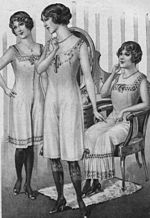1910s
The increase in the number of underwear manufacturers necessitated the birth of undergarment advertising. The first underwear print advertisement in the United States ran in the Saturday Evening Post in 1911 and featured oil paintings by J.C. Leyendecker of the "Kenosha Klosed Krotch". Early underwear advertisements placed emphasis on durability and comfort; fashion was never a selling point.
By the end of the 1910s, Chalmers Knitting Company split the union suit into upper and lower sections, effectively inventing the modern undershirt and drawers. Women wore lacier versions of this basic duo known as the camisole and drawers.
In 1913, a New York socialite named Mary Phelps Jacob changed women's fashion forever when she cobbled the first brassiere together by tying two handkerchiefs together with ribbon. Jacob's original intention was to cover the whalebone sticking out of her corset, which was visible through her sheer dress. Jacob began making brassieres for her family and friends, and word of mouth soon spread about the garment. By 1914, Jacob had a patent for her design and was marketing it throughout the United States. Although women had worn brassiere-like garments years past, Jacob's was the first to be successfully marketed and widely adopted.
In 1912, the United States had its first professional underwear designer. Lindsay "Layneau" Boudreaux, an immigrant from France established the short lived panty company "Layneau". Though her company closed within one year, it had a significant impact on many levels. Boudreaux showed the world that an American woman could establish and run a company, and she also caused a revolution in the underwear industry. Boudreaux is possibly the reason why up-scale underwear and panty stores exist today.
By the end of the decade, trouser-like "bloomers" (popularized by Amelia Jenks Bloomer 1818-1894 but invented by Elizabeth Smith Miller) gained popularity with the so-called Gibson girls who enjoyed more athletic pursuits such as bicycling and tennis. This new female athleticism helped push the corset out of style, as well. The other major factor in the corset's demise was the fact that metal was in short supply in much of the world during World War I. Steel-laced corsets were dropped in favor of the brassiere.
Meanwhile, the soldiers of World War I were issued button-front shorts as underwear. The buttons attached to a separate piece of cloth, or yoke, sewn to the front of the garment, and tightness of fit was adjusted by means of ties on the sides. This design proved so popular that it began to supplant the union suit in popularity by the end of the war. Garments of rayon also became widely available in the post-war period.
Source from : http://en.wikipedia.org/wiki








No comments:
Post a Comment